Murals
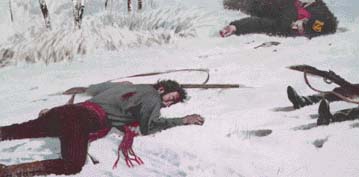
"The Battle of Duck Lake"
The Métis people were gravely concerned about retaining their language, religion, and their community as vast areas of the West were being transferred from the Hudson's Bay Company to the Canadian Government. The apparent indifference of the Government towards the Métis people led to the Battle of Duck Lake in March, 1885. Artist Ru Huang conveys the solemn, tragic and moving aftermath of conflict. It is as if the Métis fighter, even in death, is clutching the precious ground he died for. The Policeman and the Volunteer, who died no less nobly or tragically, appear to be subtly portrayed as almost strangers in the land.
This mural is dedicated to the staff and trainees of New Careers for their pride and craftsman ship in the construction of the Duck Lake Regional Interpretive Centre; the revitalization of Duck Lake's Main Street; and the Duck Lake Mural Project. This mural was made possible through the generous contributions of the Duck Lake Lions Club and the Duck Lake History Book Committee.
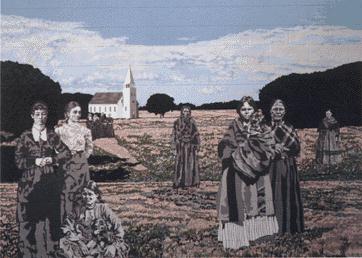
"The Women of Batoche"
Reflecting over the North West Rebellion era, let us recognize the strength, resourcefulness and determination of the Women of the Day. Standing together, here at Batoche, the place that affected them all, are: on the left, Marguerite Monet Riel, wife of Louis Riel; Theresa Gowanlock, one of the two white women taken captive after the Frog Lake "Massacre"; (seated), daughter of Chief Whitecap of the Moose Woods reserve; nursing sisters from the Order of St. John, brought from Toronto, Ontario, to nurse General Middleton's soldiers; a woman from tile family of Dakota Chief, Red Eagle; unidentified Métis woman; Angeline Dumas, married to Louis Letendre; and Marguerite Parenteau, married to Xavier Letendre, known as "Batoche".
This mural is lovingly dedicated by the artist, Laureen Marchand to her mother and by the Murals Board to the Women of Canada. This mural was made possible through the hard work and dedication of the many volunteers in the community.

"The Signing of Treaty #6"
It's August 18th, 1876, on the Carlton side of the North Saskatchewan, the day for signing Treaty #6, between the Lieutenant Governor of Manitoba and the Northwest Territories, Alexander Morris, and the Ruling Chiefs. Artist, Gus Froese has superimposed upon this mural three Indian chiefs who tower over the proceedings, but are not actually a part of it. To the left is Chief Beardy, who signed the Treaty ten days later on his own turf, then Chief Big Bear and Chief Poundmaker, who also were not part of the original signing. The whole event takes place under a foreboding sky, which hints of conflict yet to come.
This mural is dedicated to the people of the Beardy and Okemasis reserve under the leader ship of Chief Rick Gamble and the Band Council; for their keen interest in this project and for the technical and historic information they so willingly gave.
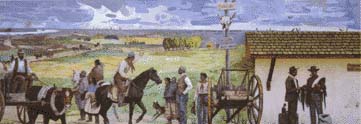
"The Carlton Trail"
Many trails crisscrossed this vast Western region of Canada, the most famous being the Carlton trail, stretching some 900 miles from present day Winnipeg to Edmonton. With realism and beauty, Artist Ru Huang brings to life the activities that took place along the trail, from the faces portrayed, to the ox driven Red River cart, to the trail and the main street slowly becoming one. This mural is dedicated to the Perillat/Colomb family, Alexis, Desire, Angeline, and Elie, who arrived in Duck Lake in 1897. Through the generosity of the present Perillat family, the creation of this mural was made possible.
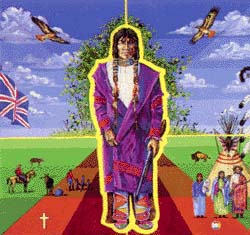
"Almighty Voice"
The tragic misunderstanding begins when a stray cow is killed by Almighty Voice for his wedding feast. In the aftermath of Almighty Voice's escape from jail, ensued one of the longest manhunts, ending in death for Sergeant Colebrook of the North West Mounted Police; and ultimately the death of Almighty Voice and two of his friends, when they were cornered in a bluff east of Duck Lake, some 18 months later, in May 1897.
Artist, Ray Keighley, portrays many messages in this mural. The yellow hue, representative of life and rebirth, the stray cow on a collision course with the buffalo, the left side representing the white people's perspective of the story of Almighty Voice; while the right side tells the perspective from the Native people's point of view.
This mural is dedicated to Chief One Arrow and all the people of the One Arrow Reserve. This mural was made possible through the generous contributions of the Duck Lake Lions Club and the Duck Lake History Book Committee.
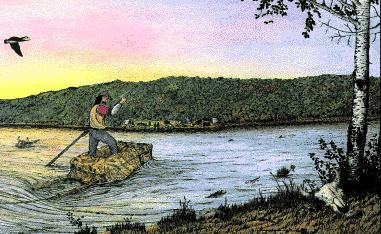
"Crossing the Saskatchewan"
In the 1870's, before ferries, crossing the Saskatchewan River was always exciting, and sometimes extremely dangerous. This mural depicts how settlers crossed the South Saskatchewan River, near Duck Lake, using the red river cart. The cart would be converted to a raft for the river crossing. The cart was unloaded and then the wheels would be removed and lashed to the cart's underside. Then the cart was reloaded and covered with buffalo skins to keep everything dry. The cart would then be pushed to the river and pulled and guided to the distant river bank. The oxen, which would drown if restrained in the water, swam separately and upon reaching the far bank, would graze patiently in the lush river bank grass.
This mural is painted from the perspective of an Indian youth, lying on the river-bank, watching the arrival of settlers. The inclusion of the old buffalo skull and the broken feather symbolically foreshadow the changes to the native way of life: The buffalo would disappear and there would be treaties signed and native settlements.
Artist Glen Scrimshaw was born and raised in Big River, in northern Saskatchewan. Since 1991 he has lived in Duck Lake. His upbringing gave him an appreciation for the beauty and serenity of nature which is characteristic of his art work. Glen is a self-taught artist whose art is noted for its detail and historical accuracy.
This mural is dedicated to the Duck Lake Lions Club and the Duck Lake History Book Committee for their invaluable contribution to the Duck Lake Arts Murals project.